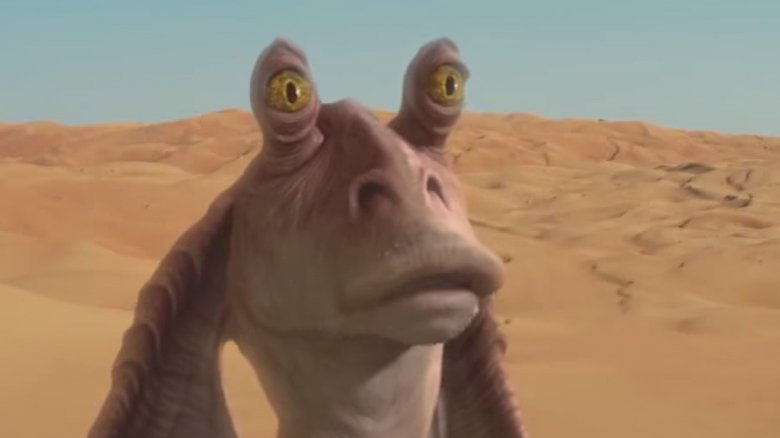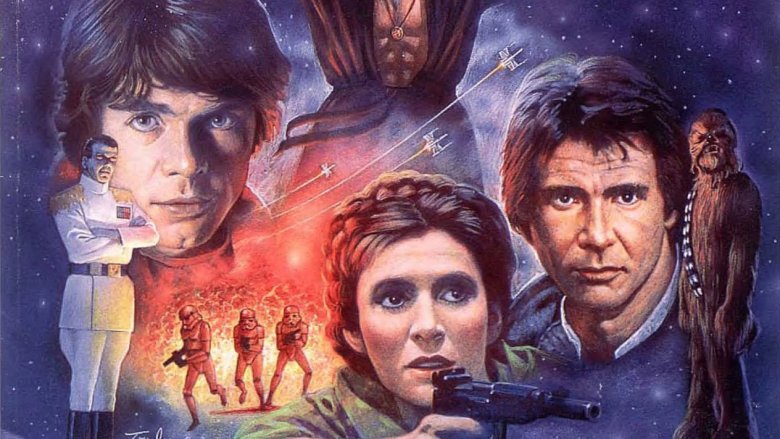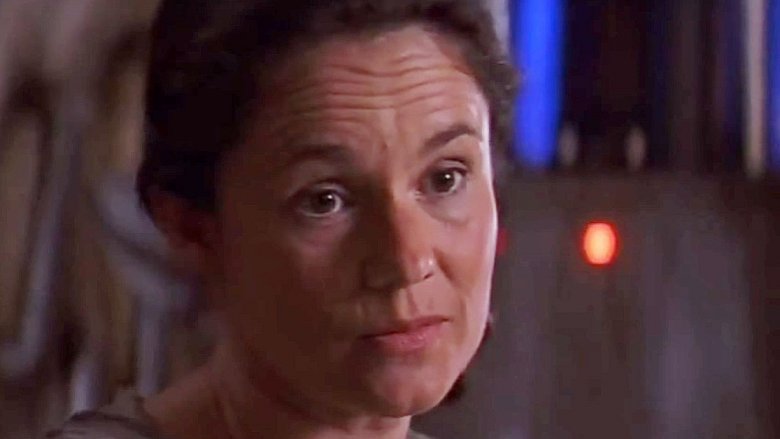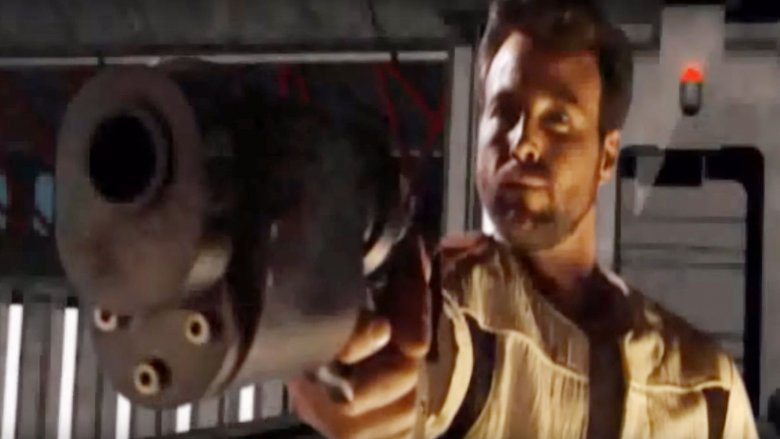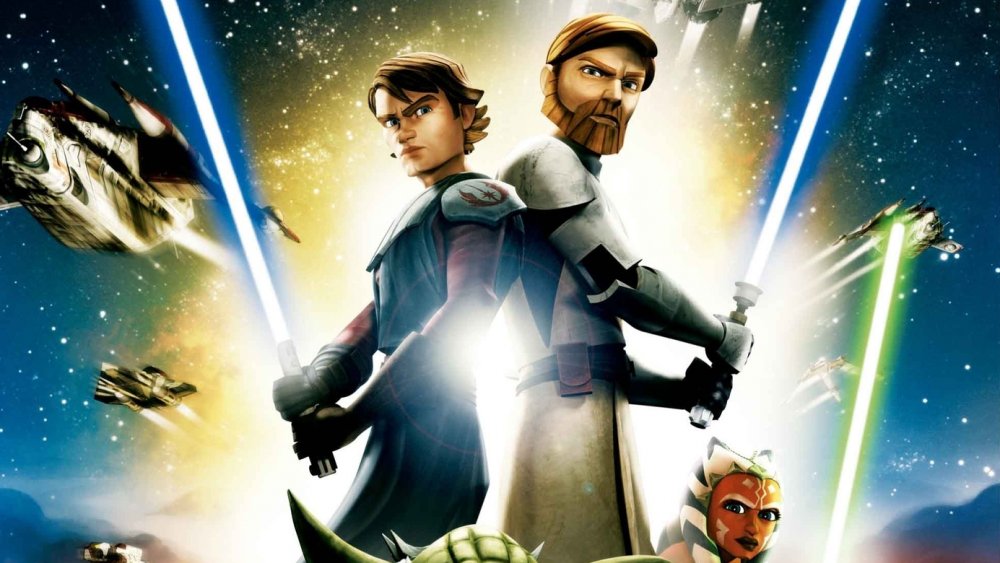What Disney Wants You To Forget About Star Wars
Star Wars is weird. It's a series that stars space wizards, a pair of slow-moving robots, and a smuggler whose best friend looks like Bigfoot. Slugs are gangsters. Teddy bears are warriors. There's an entire Star Wars movie dedicated to an economic dispute, and the most powerful creature in the Star Wars universe is a Muppet voiced by Miss Piggy.
And that's the good stuff. Over the years, Lucasfilm has taken Star Wars in some pretty weird directions, and it's no surprise that Disney seems eager to let some of the stranger decisions fall by the wayside. Sometimes, the omissions make sense. Other times, it's too bad. In both cases, it's Disney's call. When you pay $4 billion for a franchise, you're allowed to do whatever you want with it. That's just how it goes.
The entire Expanded Universe
There was a period when the media wasn't all Star Wars, all the time. It was called the early '90s, and it was a very dark time. With Return of the Jedi fading into memory and the prequels still just a glimmer in George Lucas' eye, the only consistent source of new Star Wars material was West End Games' tabletop role-playing game.
Enter Thrawn. In 1991, Bantam Books published Timothy Zahn's Heir to the Empire, the first official Star Wars story set after Return of the Jedi. The novel, which told the story of Luke, Han, and Leia's struggles against an Imperial admiral's efforts to restore the Empire, was a massive—if unexpected—hit. Zahn produced two more novels, closing out the so-called Thrawn trilogy, and the Expanded Universe was born. Before long, hundreds of Star Wars novels and spin-offs flooded the shelves, renewing interest in the franchise and reportedly encouraging Lucas to make his own return to a galaxy far, far away.
Over the years, the Empire returned in a clone body and made Luke his apprentice, Han and Leia got married and had three kids (including one who, like Kylo Ren, fell to the dark side), and Luke fell in love and got married to Mara Jade, the Emperor's former secret agent. A new Jedi academy rose and fell. An alien race called the Yuuzhan Vong invaded and wreaked havoc on the galaxy. Chewbacca died when a moon fell on top of him.
And then, Disney. Shortly after the Mouse House bought Star Wars and Lucasfilm for $4 billion, Disney threw out the Expanded Universe in order to pave the way for its own sequels, starting with The Force Awakens. Technically, the novels and comics are still in print under the "Legends" banner (and Disney seems happy to reinstate characters like Admiral Thrawn, who appeared on Star Wars Rebels, as it deems appropriate), but technically, they no longer count. For all intents and purposes, the timeline is dead, and it's not coming back.
Anakin's father, or lack thereof
If you haven't noticed, parents play a big role in the Star Wars saga. In 1980, Darth Vader's "No, I am your father" rocked movie audiences to their core. Anakin Skywalker began his journey to the dark side after Tusken Raiders kidnapped and murdered his mother. Leia's real lineage is Return of the Jedi's big reveal, the relationship between Han and Ben "Kylo Ren" Solo provides The Force Awakens with its most emotional scene, and "who are Rey's parents?" is the question that's launched a thousand fan theories.
So, given how important ancestry is to the series—especially the Skywalker line—you'd expect the question of Darth Vader's father to get at least a little attention. It doesn't, and for good reason: allegedly, he doesn't have one. If you've blocked The Phantom Menace from your memory, here's a refresher: during the film, when Qui-Gon Jinn asks Shmi Skywalker who Anakin's daddy is, she replies, "There was no father. I carried him, I gave birth, I raised him. I can't explain what happened."
That's weird, even by Star Wars standards. The implication is that the Force somehow led to Anakin's conception, which lends credence to the entire "chosen one" narrative, but you'd think that something that outside of the norm would warrant further investigation (the now-non-canon novel Darth Plagueis hints that Anakin might've been conceived as a reaction to the Sith lord's manipulation of midi-chlorians, but even in the book that's speculation). However, Disney seems content to focus on Star Wars' future, not its past, and it's likely that this question—and its religious overtones—will simply be left to fade away.
The Droids and Ewoks animated series
When Disney declared the Star Wars Expanded Universe null and void, the company was very clear about what remained canon. All six movies still counted. The Clone Wars animated series did too. As explained on StarWars.com, George Lucas created and produced The Clone Wars. That was enough to make the show, like the feature films, one of "the immovable objects of Star Wars history."
And yet, Lucas directly oversaw two other Star Wars animated series, and neither of those even merited a mention in Disney's announcement. In the '80s, with no future Star Wars films on the horizon, Lucas looked to Saturday morning cartoons to keep the franchise alive. It made sense: after all, George Lucas had always been a big fan of animation (Boba Fett made his debut in an animated segment that aired during The Star Wars Holiday Special, the only part of the program that Lucas oversaw directly). Lucasfilm teamed with the Canadian animation studio Nelvana, which had produced the Boba Fett short, to produce two animated series based on Star Wars: Droids, which followed R2-D2 and C-3PO before they crossed paths with Luke Skywalker, and Ewoks, which chronicled the little fuzzballs' adventures on Endor.
Lucas approved every script for both series, and helped director Clive Smith storyboard the Droids TV movie, The Great Heap. Long-time Lucasfilm employee Miki Herman, who worked on all three original Star Wars films, executive produced both shows. Anthony Daniels reprised his role as C-3PO for Droids, while Ben Burtt, the sound designer for all seven main Star Wars films, provided sound effects and wrote a number of episodes.
Unfortunately, neither show lasted. Lucas insisted on high-quality animation, and the shows were just too expensive to keep going (constant struggles with ABC's standards and practices department didn't help, either). Since Disney took over, neither Ewoks nor Droids have made an encore appearance, and, it looks like these shows are going to stay underground for a long, long time.
Leia's metal bikini
By all indications, Lucasfilm will be tweaking the original Star Wars trilogy forever, but we're pretty confident that Leia's slave outfit will remain a part of Return of the Jedi for the foreseeable future. That isn't stopping Disney from trying to bury the iconic outfit as deep as possible, however. According reports from various sources (including popular comic book artist J. Scott Campbell), Disney decided to stop producing merchandise featuring Leia in her metal bikini back in 2015 after fans complained about the lack of female Star Wars figures and the overall absence of women in the franchise's marketing.
We're not saying that banning slave Leia merchandise is a bad thing, even if General Leia herself, Carrie Fisher, called the entire controversy "asinine." Leia sports plenty of outfits during her time on-screen, and it makes sense to ensure that Star Wars' first lady is represented like the bad-ass that she is and not, y'know, a sex slave. Still, Leia's metal bikini is a part of Star Wars lore (and will likely be a cosplay mainstay until the end of time), and Fisher's take on the costume is probably the best way to remember it: "A giant slug captured me and forced me to wear that stupid outfit, and then I killed him because I didn't like it. And then I took it off. Backstage."
Kyle Katarn
Years before Rogue One: A Star Wars Story arrived in theaters, LucasArts told a different version of the story of how the original Death Star plans made their way to the Rebel Alliance. Dark Forces' opening mission, in which the mercenary Kyle Katarn sneaks into an Imperial base and shoots his way out with the schematics, isn't quite as epic as Rogue One's war story, but it has a much happier ending: unlike Rogue One, our heroes survive.
While Dark Forces, which came out in 1995, feels quaint in the days of Destiny and Star Wars Battlefront, at the time it was a major hit. The first level tied the game to Star Wars canon in a new and unexpected way, plunging players right into the Star Wars universe while introducing them to a fantastic new character (Katarn would go on to star in the Jedi Knight series, which let players wield a lightsaber in first-person for the very first time). Dark Forces broke LucasArts sales records when it was released, while Katarn and the game's villainous Dark Troopers were immortalized as action figures, becoming two of the first characters from the Expanded Universe to get their own toys.
Of course, these days, Katarn is gone and his biggest claim to fame belongs to Felicity Jones' Jyn Erso. Dark Forces belongs to an older generation, and Erso is a great character in her own right. Still, Kyle Katarn got those plans first. A little respect would be awfully nice.
Christmas in the Stars
George Lucas famously tried to bury The Star Wars Holiday Special. Thanks to the Internet, it didn't work. These days, every die-hard Star Wars fan has heard of, if not seen, the 1978 made-for-TV extravaganza. In The Star Wars Holiday Special, a noticeably high Carrie Fisher sings a holiday song to the tune of the main Star Wars theme. Bea Arthur serenades the patrons of the Mos Eisley cantina with "Good Night, But Not Goodbye," which is just a slowed-down version of the cantina theme. Chewbacca's extended family grunts and growls at each other in Wookie for entire scenes—without subtitles.
But while The Star Wars Holiday special lives on in infamy, Star Wars' other, far superior holiday tie-in remains relatively unknown. Christmas in the Stars came out in 1980, with music by Meco, the producer responsible for Star Wars and Other Galactic Funk. As Christmas in the Stars begins, C-3PO (voiced, as always, by Anthony Daniels, who'll do pretty much anything for a paycheck) speak-sings through the title track and "Bells, Bells, Bells." R2-D2 joins him next for "The Odds Against Christmas." An unnamed droid leads "What Do You Get a Wookie for Christmas (When He Already Owns a Comb?)," before a very young Jon Bon Jovi—yes, that Jon Bon Jovi—takes over for "We Love You R2-D2." Look, this is the album that rhymes "question" with "indigestion"—if that doesn't strike you as particularly genius, then you're beyond help.
By the end, Christmas in the Stars descends into nonsense involving Santa's son and his helper droid, S. Claus. It doesn't matter. By that point, the album has already established itself as a bona fide camp classic. Sadly, Disney doesn't seem to agree: the CD has been out of print since 1996. Thankfully, eBay has plenty of copies and MP3s of the best tracks are easy to find, provided that you know where to look.
Leia remembers her mother
In Return of the Jedi, Luke asks Leia if she remembers her mother. Her memory is hazy—mom died when Leia was young—but she notes that her mother was beautiful, kind, and a little sad. What Luke isn't telling her, of course, is that Leia's mother is also his own—they're twins, and Luke is trying to get some information about his own family.
But while Leia is exceptionally smart (she gets her PhD before she's 19, for heaven's sake), there's no way that Leia should be able to remember her mother: in Revenge of the Sith, Padmé dies during childbirth. Leia could be talking about her adoptive mother, but behind-the-scenes material makes that unlikely. Besides, if Leia is referring to anyone other than Padmé, the scene loses all of its emotional impact, because why would Luke care about the long-dead queen of Alderaan? This would be an easy plot hole to clear up (the Force is a pretty flexible plot device), but so far, Disney seems content to just let this one slip by.
The Clone Wars movie
In 2013, Disney announced that, in addition to its new Star Wars trilogy, it would produce a series of Star Wars spin-offs that fill in the gaps between the series' main episodes, and that feature side characters and/or previously unseen origin stories. The news was a big hit with both fans and investors—Disney's stock rose 2.4 percent after the announcement—and the excitement continued all the way through the release of 2016's well-received Rogue One: A Star Wars Story.
And yet, while many praised the stand-alone Star Wars movies as a way of offering new and fresh takes on the franchise, nobody mentioned that Lucasfilm had already released one theatrical Star Wars spin-off. Unfortunately, it wasn't very good.
In 2008, Lucasfilm released Star Wars: The Clone Wars, a feature edited together from the first three episodes of its then-upcoming The Clone Wars animated series, in theaters. As an entry in Star Wars canon, The Clone Wars is very important: it introduces Anakin Skywalker's apprentice, the fan-favorite character Ashoka Tano, and kicks off The Clone Wars cartoon, which revived The Phantom Menace's Darth Maul, transformed the bounty hunter Boba Fett from a cool costume into a fully-fledged character, gave some much needed personality to the proto-Stormtrooper clone soldiers, and provided extra context for Anakin's ultimate fall to the dark side.
It's also not a very good movie. Over six seasons, The Clone Wars television show transformed into a gritty, wartime drama that pushed the Star Wars universe in a number of interesting directions. The Clone Wars feature film is an emotionless, dull slog filled with stock characters and vaguely homophobic stereotypes. It currently has an 18 percent score on Rotten Tomatoes—the lowest of any Star Wars movie, including the infamous Holiday Special—and is probably best left forgotten.
David Prowse
Which actor do you most closely associate with Darth Vader? It's probably James Earl Jones, who provides Vader's iconic voice in the feature films (and, occasionally, in the Star Wars Rebels animated series). Or maybe it's Jake Lloyd or Hayden Christensen, who played pre-fall Anakin in the Star Wars prequel trilogy. If you're particularly old school, maybe you even think of Sebastian Shaw, the British thespian who briefly portrayed Vader sans mask in Return of the Jedi.
If Disney has its way, however, you definitely won't recall David Prowse, the man who actually wore the Darth Vader suit in episodes four, five, and six. Prowse has a rocky relationship with Lucasfilm, and for good reason. Reportedly, Prowse didn't know that he was going to be dubbed over for A New Hope until the film premiered. In interviews, Prowse claims that George Lucas promised that Prowse would play Vader without his helmet, and then gave the part to Shaw. In 1978, much to Lucas' chagrin, Prowse told newspapers that Vader was Luke Skywalker's father, although how he knew that—the big reveal was kept from the actors during filming—remains unknown.
As a result, Prowse has been mostly removed from Star Wars history. Hayden Christensen played the fully-suited Vader who debuted in Revenge of the Sith. While Disney brought back almost every living Star Wars cast member for The Force Awakens—including the 71-year-old Peter Mayhew, who plays Chewbacca—Prowse wasn't invited to reprise his role as Vader in Rogue One: A Star Wars Story (the part went to Game of Thrones and Guardians of the Galaxy actor Spencer Wilding instead). In 2010, George Lucas banned Prowse from attending official Star Wars conventions, claiming that he'd "burnt too many bridges." Given that we only have Prowse's side of the story, it's hard to tell exactly what's going on—but don't expect Prowse to return to the Star Wars universe any time soon. That ship has sailed.
Jar Jar Binks
Okay, so it's not like Disney is trying to hide Jar Jar Binks, exactly. They're just finally in on the joke. Before The Phantom Menace, which was widely expected to revolutionize the visual effects industry like A New Hope did 20 years before, Lucasfilm pushed Jar Jar as the "the first walking, talking, CG film star." To be fair, it's hard to imagine that we would've gotten The Lord of the Rings' Gollum or Planet of the Apes' Caesar if Jar Jar hadn't paved the way.
On the other hand, well, he's still Jar Jar Binks. Adults—including people who actually worked on the film—found Jar Jar remarkably annoying, and soon the character came to represent the hollow characterization and the emphasis on technology over humanity that plague the Star Wars prequels. Some critics accused Jar Jar of promoting racist stereotypes. Ahmed Best, who voiced Jar Jar and played him on set, received death threats from irritated fans.
Jar Jar's stock fell accordingly. He only has a couple of lines in Attack of the Clones, in which he casts the deciding vote in the Galactic Senate, allowing soon-to-be Emperor Palpatine to take control. He doesn't speak at all in The Revenge of the Sith, and only appears as a supporting player in a couple of scenes.
In the Disney era, Jar Jar's been reduced to a punchline. Gungans got a passing mention in The Mandalorian. In Disney Infinity 3.0, a carbonite-encased Jar Jar Binks decorates the walls of Jabba the Hutt's palace. In Chuck Wendig's novel Star Wars Aftermath: Empire's End, Jar Jar appears as a street performer, where, like real life, kids love him and adults treat him like a pariah. Before The Force Awakens premiered, director J. J. Abrams threatened to kill him off entirely. "I have a thought about putting Jar Jar Binks's bones in the desert," Abrams said. "Only three people will notice, but they'll love it." That's pretty harsh, but Abrams has a point. Jar Jar hasn't played a major part in Star Wars for years, and so far, he hasn't been missed.
